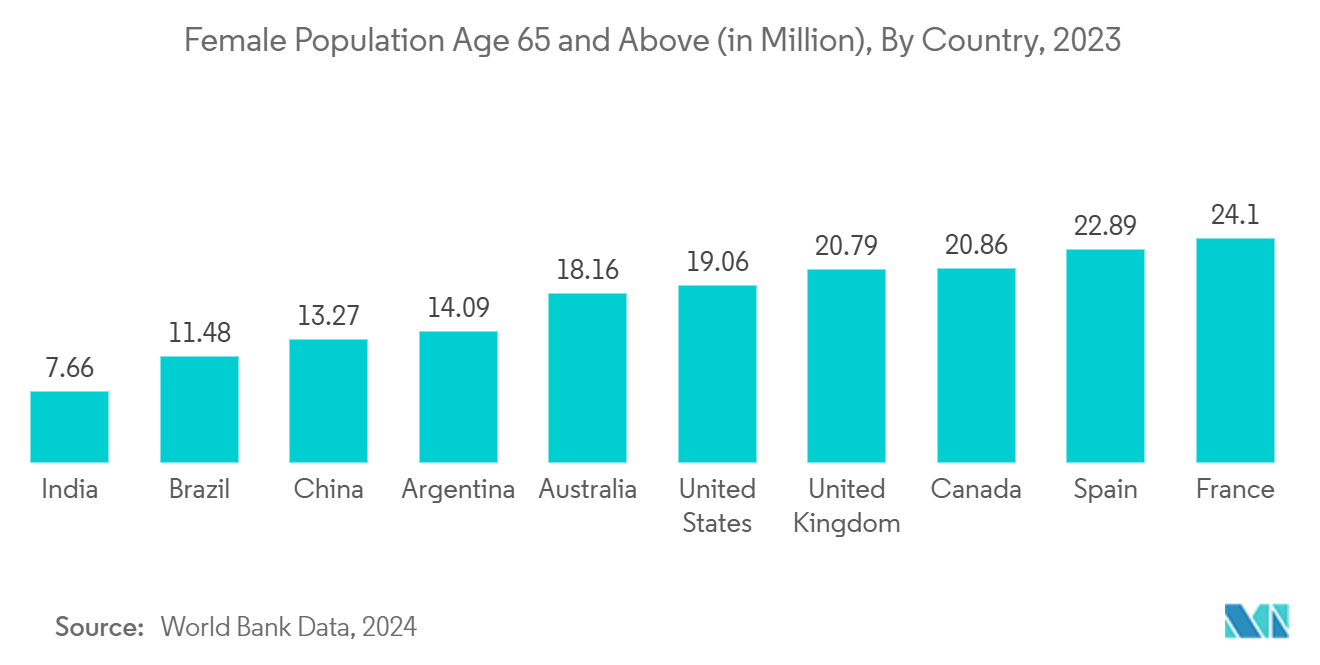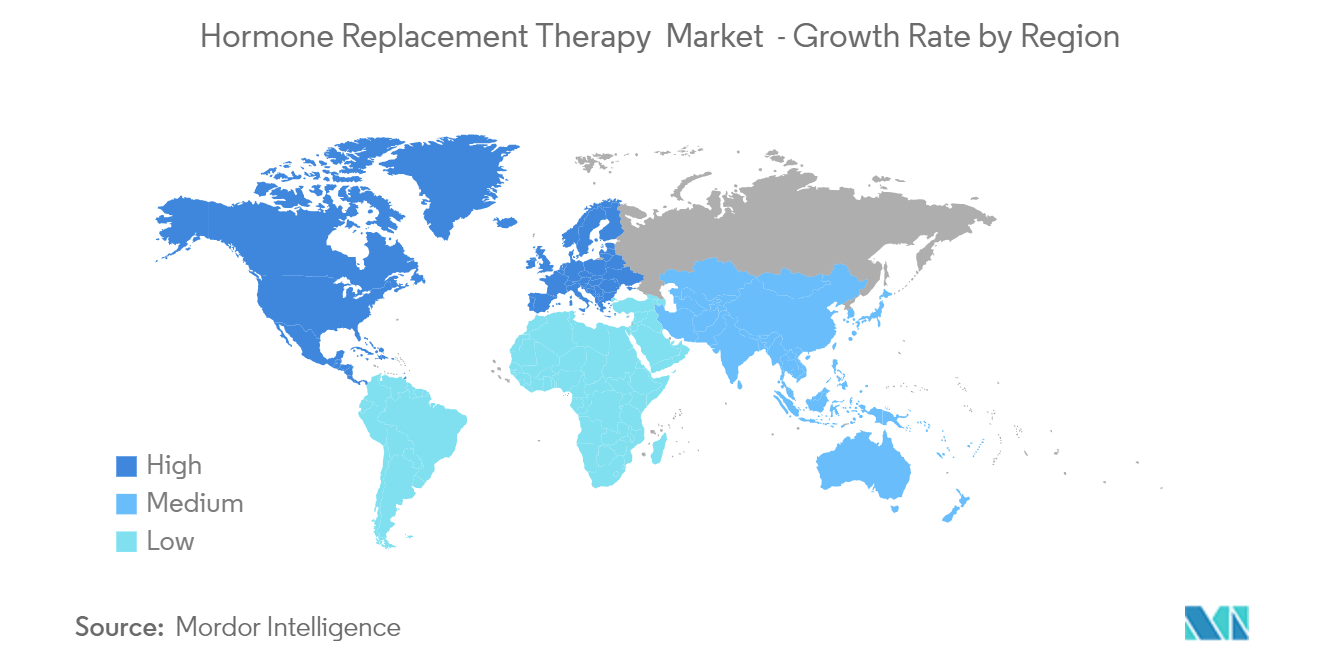Market Trends of Global Hormone Replacement Therapy Industry
The Menopause Segment is Expected to Register a Healthy Annual Growth During the Forecast Period
Menopause marks the end of women's menstrual cycles. It is diagnosed after a woman has gone 12 months without a menstrual period. Menopause can happen at an age between 40 and 50. HRT improves the quality of life and extends longevity for many elderly women, whether starting at menopause or a later stage.
The increasing aging population is likely to increase the issue of menopause among women, which will boost the demand for HRT. For instance, according to data from the OECD, as of January 2024, there were 14,773,554 women aged between 40 and 74 in Italy, constituting 49% of the total female population. This demographic presents a significant portion of the population experiencing menopause or perimenopause, indicating a substantial market for HRT therapy.
Additionally, according to the Spain National Statistics Institute (NSI), the number of women experiencing menopause in Spain has reached unprecedented levels, marking a historic high. As of January 2023, around 4 million Spanish women aged 45 to 55 experienced menopause, marking a 2% increase from the previous year. This cohort now constitutes 7.9% of the total population, underscoring the growing relevance of menopausal symptoms and their management. Thus, the high prevalence of menopause is expected to drive the market for HRT as these treatments are effective in menopausal issues, thereby boosting the market growth.
Heightened regulatory engagement in establishing menopause treatment guidelines is poised to expand the market. For instance, in July 2024, a report from the British Menopause Society reaffirmed that hormone replacement therapy (HRT) is the leading treatment for alleviating menopausal symptoms and scorching flashes. The National Institute for Health and Care Excellence (NICE) guidelines, cited in the same report, unequivocally support HRT as a primary treatment option. This endorsement of HRT underscores its dominant role in the market yet highlights the limitations and gaps in alternative treatment options.
Additionally, government-supportive initiatives that help women in menopause by launching several schemes for HRT therapy are expected to bolster segment growth. For instance, in April 2023, the United Kingdom government introduced a new hormone replacement therapy (HRT) Prescription Prepayment Certificate (PPC) to make HRT more affordable for women facing menopause symptoms. The HRT PPC reduces prescription costs to GBP 19.30 (USD 25.66) annually. This move significantly alleviates the financial strain on women who often need multiple HRT prescriptions. The certificate covers a range of HRT products, including patches, tablets, and topical treatments. Women can use the PPC at various times throughout the year. It is projected that approximately 400,000 women will benefit from this initiative, collectively saving them hundreds of pounds each year on prescriptions. Thus, such government initiatives support the adoption of HRT, driving the segment growth.
Thus, owing to the factors above, such as increasing women's aging and the high burden of menopause issues and symptoms, the government supports the menopause indication segment and is expected to witness significant growth during the forecast period.

North America Holds the Largest Market Share, and it is Expected to do the Same During the Forecast Period
The North American market for hormone replacement therapy (HRT) is growing due to increased awareness of menopause and its symptoms, an aging population, and the rise in personalized healthcare approaches. Enhanced education about treatment options and improved formulations are also driving demand. Additionally, the increasing prevalence of hormone deficiency diseases such as thyroid disorders, Cushing syndrome, and cystic fibrosis is driving market expansion.
Awareness of HRT as a viable option alongside lifestyle is expected to expand the market as women explore comprehensive management strategies. For instance, in June 2023, Sun Life teamed up with the Menopause Foundation of Canada (MFC) to enhance awareness of women's health issues. They focus on improving support for menopause and its symptom management in professional settings. As part of this collaboration, they are creating resources tailored for employers. Thus, greater awareness empowers women to take charge of their health, leading to a more robust market for hormone replacement therapies.
Also, government initiatives aimed at assisting women during menopause, including the launch of various schemes for HRT therapy, are anticipated to drive growth in this segment. For instance, in April 2024, the provincial and federal governments partnered to offer complementary menopausal hormone therapy to residents of BC, as outlined in a newly established memorandum of understanding. British Columbia's Health Minister, Adrian Dix, announced that the province was poised to receive between USD 30 million and USD 40 million from the federal government. This funding, contingent upon the Senate's approval of the bill, aimed to enhance access to menopausal hormone therapy. Additionally, the memorandum encompassed financial provisions to bolster contraception and diabetes coverage.
Market players are increasingly launching new products, and with regulatory approvals from the US FDA and other authorities, the market is poised for growth during the forecast period. For instance, in September 2023, Ascendis Pharma A/S introduced SKYTROFA (lonapegsomatropin) in Germany. This growth hormone, approved by the European Union, is designated for a once-weekly treatment. It targets children and adolescents aged 3 to 18 who experience growth failure from insufficient endogenous growth hormone secretion, commonly called growth hormone deficiency (GHD). Thus, such launches are expected to increase demand for this drug, driving market growth.
Therefore, because of the factors listed above, the market for hormone replacement therapy in North America is expected to grow during the forecast period.


